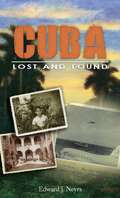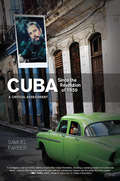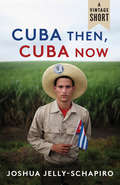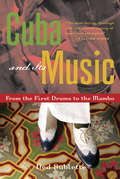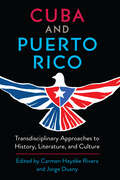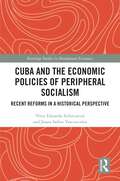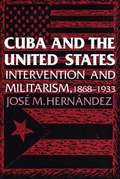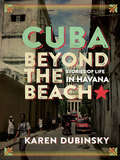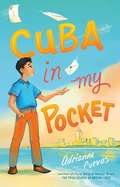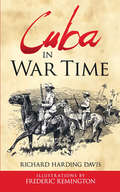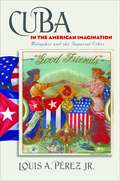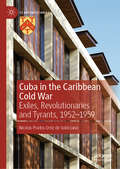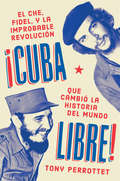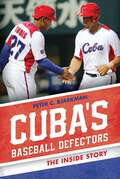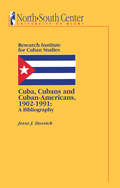- Table View
- List View
Cuba Lost and Found
by Edward J. NeyraFrom 1990 to 2000, the Hispanic population increased nearly 60 percent and is one of the nation's largest minority groupIn 1962, eleven-year-old Edward Neyra left his homeland of Cuba as part of a secret operation that relocated 14,000 children to the United States before the Cuban Missile Crisis. In Cuba: Lost and Found, he tells the dramatic story of his life before the Revolution, from his carefree early years in the city of Cardenas and Varado Beach through his struggles to find a place in his new country, to his hard-won achievement of the American Dream. This engaging Horatio Alger story limns a life well lived.
Cuba Loves Baseball: A Photographic Journey
by Bob Costas Ira Block Sigfredo BarrosAccording to the New York Times, Cuba is at an historic turning point. As Cuba catches up with political and economic changes, baseball will inevitably catch up and change as well. In Cuba Loves Baseball, photographer Ira Block, who has spent the past three years photographing the culture of Cuba through baseball, has assembled more than one hundred images of baseball players of all ages. In doing so, Block helps to preserve baseball's enduring presence in Cuba. The colorful photos cover everything from grass roots baseball to the pro teams, from portraits of old-timers to children playing baseball in the streets, and from exuberant fans at stadiums to vendors selling traditional food before the games. Cuba Loves Baseball incorporates sport with culture in a country that has been "closed" for so many years. It makes the perfect gift for sports fans, people interested in Cuba and travel, men and women who played baseball as children in cities or rural areas, and parents who have children playing baseball now.
Cuba Since the Revolution of 1959: A Critical Assessment
by Samuel Farber“Frequent insights, stimulating historical comparisons, and command of the data relating to Cuba’s economic and social performance.” —Foreign AffairsUncritically lauded by the left and impulsively denounced by the right, the Cuban Revolution is almost universally viewed one dimensionally. In this book, Samuel Farber, one of its most informed left-wing critics, provides a much-needed critical assessment of the Revolution’s impact and legacy.“The Cuban story twists and turns as we speak, so thank goodness for scholars such as Samuel Farber, an unapologetic Marxist whose knowledge of Cuban affairs is unrivalled . . . In this excellent, necessary book, Farber takes stock of fifty years of revolutionary control by recognizing achievements but lambasting authoritarianism.” —Latin American Review of Books“A courageous and formidable balance-sheet of the Cuban Revolution, including a sobering analysis of a draconian ‘reform’ program that will only deepen the gulf between revolutionary slogans and the actual life of the people.” —Mike Davis, author of Planet of Slums
Cuba Then, Cuba Now (A Vintage Short)
by Joshua Jelly-SchapiroIn an enthralling blend of travel literature and history, Joshua Jelly-Schapiro provides an insightful portrait of a mesmerizing place. Building on the in-depth exploration of Cuba's society, culture, and politics that formed part of his recent book, Island People: The Carribbean and the World, Jelly-Schapiro adds new material covering the changes that followed the death of Fidel Castro. The result is a concise and up-to-date overview of Cuba's past and present and its enduring grip on the world’s imagination.
Cuba and Its Music: From the First Drums to the Mambo
by Ned SubletteThis entertaining history of Cuba and its music begins with the collision of Spain and Africa and continues through the era of Miguelito Valdés, Arsenio Rodríguez, Benny Moré, and Pérez Prado. It offers a behind-the-scenes examination of music from a Cuban point of view, unearthing surprising, provocative connections and making the case that Cuba was fundamental to the evolution of music in the New World. The ways in which the music of black slaves transformed 16th-century Europe, how the claves appeared, and how Cuban music influenced ragtime, jazz, and rhythm and blues are revealed. Music lovers will follow this journey from Andalucía, the Congo, the Calabar, Dahomey, and Yorubaland via Cuba to Mexico, Puerto Rico, Saint-Domingue, New Orleans, New York, and Miami. The music is placed in a historical context that considers the complexities of the slave trade; Cuba's relationship to the United States; its revolutionary political traditions; the music of Santería, Palo, Abakuá, and Vodú; and much more.
Cuba and Puerto Rico: Transdisciplinary Approaches to History, Literature, and Culture
by Jorge Duany Carmen Haydée RiveraThe intertwined stories of two archipelagos and their diasporas This volume is the first systematic comparative study of Cuba and Puerto Rico from both a historical and contemporary perspective. In these essays, contributors highlight the interconnectedness of the two archipelagos in social categories such as nation, race, class, and gender to encourage a more nuanced and multifaceted study of the relationships between the islands and their diasporas. Topics range from historical and anthropological perspectives on Cuba and Puerto Rico before and during the Cold War to cultural and sociological studies of diasporic communities in the United States. The volume features analyses of political coalitions, the formation of interisland sororities, and environmental issues. Along with sharing a similar early history, Cuba and Puerto Rico have closely intertwined cultures, including their linguistic, literary, food, musical, and religious practices. Contributors also discuss literature by Cuban and Puerto Rican authors by examining the aesthetics of literary techniques and discourses, the representation of psychological space on the stage, and the impacts of migration. Showing how the trajectories of both archipelagos have been linked together for centuries and how they have diverged recently, Cuba and Puerto Rico offers a transdisciplinary approach to the study of this intricate relationship and the formation of diasporic communities and continuities. Publication of this work made possible by a Sustaining the Humanities through the American Rescue Plan grant from the National Endowment for the Humanities.
Cuba and the Economic Policies of Peripheral Socialism: Recent Reforms in a Historical Perspective (Routledge Studies in Development Economics)
by Vitor Eduardo Schincariol Joana Salém VasconcelosDeparting from the category of 'peripheral socialism', this book offers an economic history of the Cuban revolution between 1959 and 2019, with a focus on the period that ranges between 2008 and 2018. The core of the research is the administration of Raúl Castro and the economic and social reforms introduced by it under the concept of socialism update. The book describes Cuba’s recent economic policies and analyses the structure and dynamics of Cuba’s economic changes, offering a panoramic view which can serve as an introduction to further more detailed analyses. The book also offers an interpretation of Cuba’s socialism in light of the Latin American political economy of underdevelopment, so as to interpret Cuba’s structural economic performance. The analytical background will enable readers to understand the contemporary crises in Cuba, with a balanced look at the triumphs and limits of its peripheral socialism. It will find an audience among scholars and researchers of economic development and history, macroeconomics, Latin American and Cuban Studies, Socialism Studies, and related areas. It will also be of interest to economists, politicians, diplomats, journalists, and NGOs.
Cuba and the Missile Crisis
by Carlos Lechuga Mary ToddA fascinating insight into one of the most serious episodes of the Cold War written by a key protagonist, Cuba's ambassador to the UN Carlos Lechuga, who for the first time reveals Kennedy's overtures for a dialogue with Castro.
Cuba and the Politics of Passion
by Fernández Damián J.Damián Fernández characterizes the politics of passion as the pursuit of a moral absolute for the nation as a whole. While such a pursuit rallied the Cuban people around charismatic leaders such as Fidel Castro, Fernández finds that it also set the stage for disaffection and disconnection when the grand goal never fully materialized. At the same time, he reveals how the politics of affection-taking care of family and friends outside the formal structures of government-has paradoxically both undermined state regimes and helped them remain in power by creating an informal survival network that provides what the state cannot or will not.
Cuba and the Tempest
by Eduardo GonzálezIn a unique analysis of Cuban literature inside and outside the country's borders, Eduardo Gonzalez looks closely at the work of three of the most important contemporary Cuban authors to write in the post-1959 diaspora: Guillermo Cabrera Infante (1929-2005), who left Cuba for good in 1965 and established himself in London; Antonio Benitez-Rojo (1931-2005), who settled in the United States; and Leonardo Padura Fuentes (b. 1955), who still lives and writes in Cuba. Through the positive experiences of exile and wandering that appear in their work, these three writers exhibit what Gonzalez calls "Romantic authorship," a deep connection to the Romantic spirit of irony and complex sublimity crafted in literature by Lord Byron, Thomas De Quincey, and Samuel Taylor Coleridge. In Gonzalez's view, a writer becomes a belated Romantic by dint of exile adopted creatively with comic or tragic irony. Gonzalez weaves into his analysis related cinematic elements of myth, folktale, and the grotesque that appear in the work of filmmakers such as Alfred Hitchcock and Pedro Almodovar. Placing the three Cuban writers in conversation with artists and thinkers from British and American literature, anthropology, philosophy, psychoanalysis, and cinema, Gonzalez ultimately provides a space in which Cuba and its literature, inside and outside its borders, are deprovincialized.
Cuba and the United States: Intervention and Militarism, 1868-1933
by José M. HernándezThis study will be of interest to all students of hemispheric relations. It presents not only a more accurate picture of the Cuba spawned by American intervention, but also the Cuban side of a story that too frequently has been told solely from the U.S. point of view.
Cuba beyond the Beach: Stories of Life in Havana
by Karen DubinskyHavana is Cuba’s soul: a mix of Third World, First World, and Other World. After over a decade of visits as a teacher, researcher, and friend, Karen Dubinsky looks past political slogans and tourist postcards to the streets, neighbourhoods, and personalities of a complicated and contradictory city. Her affectionate, humorous vignettes illustrate how Havana’s residents—old Communist ladies, their sceptical offspring, musicians, underground vendors, entrepreneurial landlords, and poverty-stricken professors—go about their daily lives. As Cuba undergoes dramatic change, there is much to appreciate, and learn from, in the unlikely world Cubans have collectively built for themselves. A portion of the proceeds from the sale of this book will go to the Queen’s University Student Overseas Travel Fund—The Sonia Enjamio Fund, which funds Cuban/Canadian student exchange.
Cuba en la encrucijada
by Leila GuerrieroUn libro de crónicas cubanas de la mano de doce de los más prestigiosos periodistas y escritores de nuestro tiempo. El cambio en Cuba es innegable, pero ¿qué significa realmente? ¿Cómo afecta a los propios cubanos? Una colección de ensayos de la mano de doce de los más prestigiosos periodistas y escritores actuales que buscan dibujar el mejor retrato de la Cuba contemporánea. Ya sea a través del perfil de Eusebio Leal, los bailarines del Tropicana Club, la cultura homosexual de la ciudad de La Habana o los rituales de belleza de las cubanas incluso en tiempos de penuria, este libro es una excepcional instantánea de los tiempos históricos que vivimos
Cuba en la encrucijada: 12 Perspectivas Sobre La Continuidad Y El Cambio En La Habana Y En Todo El País
by Leila GuerrieroUn libro de crónicas cubanas de la mano de doce de los más prestigiosos periodistas y escritores de nuestro tiempo que abarca política y arte, música y béisbol, presente y pasado, y nos ofrecen una excepcional instantánea de la particular encrucijada en la que se encuentra la sociedad cubana. De todas las preguntas que debe hacerse el periodismo, solo hay una que, si hablamos de Cuba, puede responderse fácilmente: dónde. Todo el mundo sabe más o menos dónde queda Cuba. Para las demás: qué es Cuba, quiénes son los cubanos, cómo es Cuba, cuándo comenzó Cuba a ser lo que es, por qué Cuba es como es, y diversas variaciones y combinaciones de lo mismo no solo no hay respuestas fáciles sino que cada quien parece tener las suyas. Los doce textos que componen este libro procuran alejarse de los reduccionismos más tópicos y contar el país desde el territorio más peligroso, y por lo mismo más interesante, de la duda y la contradicción. Contar Cuba -como contar el desembarco en Normandía o la caída del Muro de Berlín- es contar la Historia en mayúsculas: una tarea ambiciosa. Pero, en el tartamudeo ametrallado de los tiempos presentes, estos son algunos intentos.» Leila Guerriero
Cuba en la encrucijada: 12 perspectivas sobre la continuidad y el cambio en la habana y en todo el país
by Leila GuerrieroA glimpse into the changing landscape of Cuban culture and politics as told by 12 award-winning journalists.[Spanish-language original. Title translates to Cuba on the Verge]Cuba on the Verge is a collection of essays by twelve of the world's most celebrated writers, ranging from Jon Lee Anderson, Leonardo Padura and Francisco Goldman, to Patricia Engel, Pedro Juan Gutiérrez and Silvio Rodríguez. Standing on both sides of the divide -- Cubans from the inside looking out and foreigners from the outside looking in -- these twelve authors come together to paint a never before seen portrait of contemporary Havana. From Pablo Ordaz's profile of Eusebio Leal, the Havana City historian responsible for restoring Old Havana to Francisco Goldman's piece on the Tropicana Club dancers he met twenty years ago and where they are now, to Rubén Gallo's exploration of Havana's gay culture to Wendy Guerra's retelling of how Cuban women have managed to maintain their beauty rituals even in times of need, Cuba on the Verge is a privileged glimpse at what we have before us; a historic snapshot of these interesting times.
Cuba hasta siempre
by Magdalena SoléMagdalena Solé first visited Cuba in 2011 and has returned every year since, enchanted by the place and the people who live in this slender stretch of land. Her photographs reveal the stirrings of transformation, however subtle and hard to see, and reflect a Cuba that is both tough and vulnerable. Cuba hasta siempre consists of more than 150 full-color photographs taken by Solé, accompanied by a foreword written by Time columnist and travel writer Pico Iyer. With minimal text, this book offers a view of Cuba beyond the tourist trade and the wealthy upper class. The photographs portray everyday settings and people engaged in daily tasks. A visual encounter with magical realism, this collection constructs an atmosphere of pervasive timelessness, a photographic time capsule. Memorabilia and objects from Cuba’s revolutionary past linger in the present, while life goes on. These soulful images offer a new visual perspective on Cuba past and present. The Wall Street Journal called Solé’s images “lushly colorful,” “formally striking,” “restless,” and “electrify[ing].”
Cuba in My Pocket
by Adrianna CuevasBy the author of 2021 Pura Belpré Honor Book The Total Eclipse of Nestor Lopez, a sweeping, emotional middle grade historical novel about a twelve-year-old boy who leaves his family in Cuba to immigrate to the U.S. by himself, based on the author's family history. <p><p> “I don’t remember. Tell me everything, Pepito. Tell me about Cuba.” <p><p> When the failed Bay of Pigs invasion in 1961 solidifies Castro’s power in Cuba, twelve-year-old Cumba’s family makes the difficult decision to send him to Florida alone. Faced with the prospect of living in another country by himself, Cumba tries to remember the sound of his father’s clarinet, the smell of his mother’s lavender perfume. <p><p> Life in the United States presents a whole new set of challenges. Lost in a sea of English speakers, Cumba has to navigate a new city, a new school, and new freedom all on his own. With each day, Cumba feels more confident in his new surroundings, but he continues to wonder: Will his family ever be whole again? Or will they remain just out of reach, ninety miles across the sea?
Cuba in War Time
by Richard Harding Davis Frederic RemingtonBefore the start of the Spanish-American War, newspaper mogul William Randolph Hearst sent star reporter Richard Harding Davis and acclaimed illustrator Frederic Remington to Cuba to cover the simmering rebellion. Remington grew restless at his post and assured his employer that nothing newsworthy was likely to occur; Hearst reputedly replied, "Please remain. You furnish the pictures and I'll furnish the war."This controversial 1897 book played an integral part in the United States' involvement in the conflict. Richard Harding Davis was among the most famous and widely read journalists of his era. His sensational reports, which combined a sense of adventure with a highly personal perspective, anticipated the more literary journalism of later decades. Davis's accounts of Spanish atrocities and misconduct helped pave the way for a war that led to the establishment of American colonies in the Caribbean and Pacific. Crackling with energy and drama, these historic and highly readable reports are complemented by 24 of Remington's atmospheric illustrations.
Cuba in the American Imagination
by Louis A. PérezFor more than two hundred years, Americans have imagined and described Cuba and its relationship to the United States by conjuring up a variety of striking images--Cuba as a woman, a neighbor, a ripe fruit, a child learning to ride a bicycle. Louis A. Perez Jr. offers a revealing history of these metaphorical and depictive motifs and discovers the powerful motives behind such characterizations of the island as they have persisted and changed since the early nineteenth century. Drawing on texts and visual images produced by Americans ranging from government officials, policy makers, and journalists to travelers, tourists, poets, and lyricists, Perez argues that these charged and coded images of persuasion and mediation were in service to America's imperial impulses over Cuba.
Cuba in the Caribbean Cold War: Exiles, Revolutionaries and Tyrants, 1952-1959 (St Antony's Series)
by Nicolás Prados Ortiz de SolórzanoThis book argues that during the Cuban Revolution (1952–1958), Fidel Castro, his allies, and members of the Movimiento 26 de Julio tapped into a larger network of transnational revolutionaries who sought to overthrow the region’s dictatorships. With his research in multiple archives including those in Cuba, Prados offers a new, transnational perspective on conflicts over dictatorship and democracy, which shaped the Caribbean in the decades that followed World War II. The book traces the roots of the ‘Caribbean Legion’, a transnational network of anti-dictatorial revolutionaries, before detailing how Castro and many of his allies in exile exploited this web during the struggle against Fulgencio Batista. Contacts in this network provided the Cuban revolutionaries with crucial military, financial, and diplomatic support from the democratic governments of José Figueres in Costa Rica, and Rómulo Betancourt in Venezuela, entangling the Cuban revolutionaries in a larger regional struggle between democratic regimes and military dictatorships. This transnational involvement shaped the revolutionary regime of 1959 and had far-reaching repercussions for the larger geopolitical dynamics in the region, and for the Cold War as a whole.
Cuba libre \ ¡Cuba libre! (Spanish edition): El Che, Fidel y la improbable revolución que cambió la historia del mundo
by Tony PerrottetCómo una banda de guerrilleros autoentrenados derrocó a un dictador y cambió la historia del mundo. Este libro describe cómo un grupo de revolucionarios, muchos de ellos jóvenes privilegiados recién egresados de la universidad, especializados en literatura y jóvenes abogados, se transformaron en guerrilleros de la selva y derrotaron a 50.000 soldados profesionalmente entrenados y equipados para derrocar al dictador Fulgencio Batista, apoyado por Estados Unidos.
Cuba's Baseball Defectors: The Inside Story
by Peter Costa Bjarkman&“Takes an inside look into the wave of player departures that has rocked the game both in Cuba and the U.S., while providing historical perspective.&” —USA Today The stellar play and fascinating backstories of exiled Cuban sluggers and hurlers has become part of Major League Baseball history. On-field exploits by colorful Dodgers outfielder Yasiel Puig, AL rookie-of-the-year José Abreu, home run derby champion Yoenis Céspedes, radar-gun busting Cincinnati fast-baller Aroldis Chapman, and a handful of others have been further enhanced by feel-good tales of desperate Cuban superstars risking their lives to escape Fidel Castro&’s communist realm and chase an American Dream of financial and athletic success. But a truly ugly underbelly to this story has also slowly emerged—one that involves human smuggling operations financed by Miami crime syndicates, operated by Mexican drug cartels, and conveniently ignored by ball clubs endlessly searching for fresh waves of international talent. Given rare access to Cuba and its ballplayers, Peter C. Bjarkman has spent over twenty years traveling to all corners of the island getting to know the top Cuban stars and witnessing their struggles and triumphs. In this book, Bjarkman places events in the context of Cuban baseball history and tradition before delving into the stories of the major Cuban stars who have left the island. He reveals their personal histories, explains the events that led them to defect from their homeland, and details their harrowing journeys to US shores. Players whose big-league dreams failed are also discussed, as are Cuba&’s efforts to stem the defection tide through working agreements with the Japanese and Mexican leagues. Cuba&’s Baseball Defectors will fascinate baseball fans, those interested in the history of US-Cuba relations, and those wanting to learn more about the unsavory story of human trafficking in the name of baseball glory. &“A revelation . . . an original social history for sports enthusiasts and readers interested in past and future Cuba–U.S. ties.&” —Library Journal Includes photos
Cuba's Car Culture: Celebrating the Island's Automotive Love Affair
by Tom Cotter Bill WarnerCuba's Car Culture drives through Cuba's love of American cars of the '40s and '50s, and the ingenuity that keeps them running despite the U.S. embargo.2017 Silver Medal Winner of the International Automotive Media Competition! The story of how Cuba came to be trapped in automotive time is a fascinating one. For decades, the island country had enjoyed healthy tourism trade and American outpost status, and by the 1950s it had the highest per capita automotive purchasing of any Latin American country. But when Cuba fell to communist rebels in 1959, so ended the inflow of new cars. Since then, trade embargo forced Cuba's car enthusiasts to develop a unique and insular culture, one marked by great creativity, such as: -Keeping a car alive with no opportunity to acquire replacement parts -Customizing a car with no access to aftermarket parts -Drag racing with no drag stripIn many ways, Cuba is an automotive time warp, where the newest car is a 1959 Chevy or perhaps one of the Soviet Ladas. Cuba's Car Culture offers an inside look at a unique car culture, populated with cars that have been cut off from the world so long that they've morphed into something else in the spirit of automotive survival.Authors Tom Cotter and Bill Warner (founder of the Amelia Island Concours) take readers on a whirlwind tour of all things automotive, beginning with Cuba's pre-Castro car and racing history, up to today's lost collector cars, street racing, and the challenges of keeping decades-old cars on the road.Cuba's Car Culture is illustrated throughout with rare historical photos as well as contemporary photos of Cuba's current car scene. For anyone who enjoys classic cars, whether they're old Chevy Bel-Airs, Studebakers, or Ford Fairlanes, a cruise around Cuba will make you feel like a kid in a candy store.
Cuba's Racial Crucible: The Sexual Economy of Social Identities, 1750–2000 (Blacks in the Diaspora)
by Karen Y. MorrisonThis prize-winning study examines the historical interplay of racial identity, nationality, and family formation in Cuba from the 18th century to today.Since the 19th century, there have been two opposing perspectives on Cuban racial identity: one that frames Cubans as white, and one that sees them as racially mixed based on acceptance of African descent. For the past two centuries, these competing views of have remained in continuous tension, while Cuban women and men make their own racially oriented decisions about choosing partners and family formation.Cuba&’s Racial Crucible explores the historical dynamics of Cuban race relations by highlighting the role race has played in reproductive practices and genealogical memories associated with family formation. Karen Y. Morrison reads archival, oral-history, and literary sources to demonstrate the ideological centrality and inseparability of "race," "nation," and "family," in definitions of Cuban identity. Morrison also analyzes the conditions that supported the social advance and decline of notions of white racial superiority, nationalist projections of racial hybridity, and pride in African descent.Winner, NECLAS Marissa Navarro Best Book Prize
Cuba, Cubans and Cuban-Americans: A Bibliography
by Jesse J. DossickFirst Published in 2018. Routledge is an imprint of Taylor & Francis, an Informa company.
